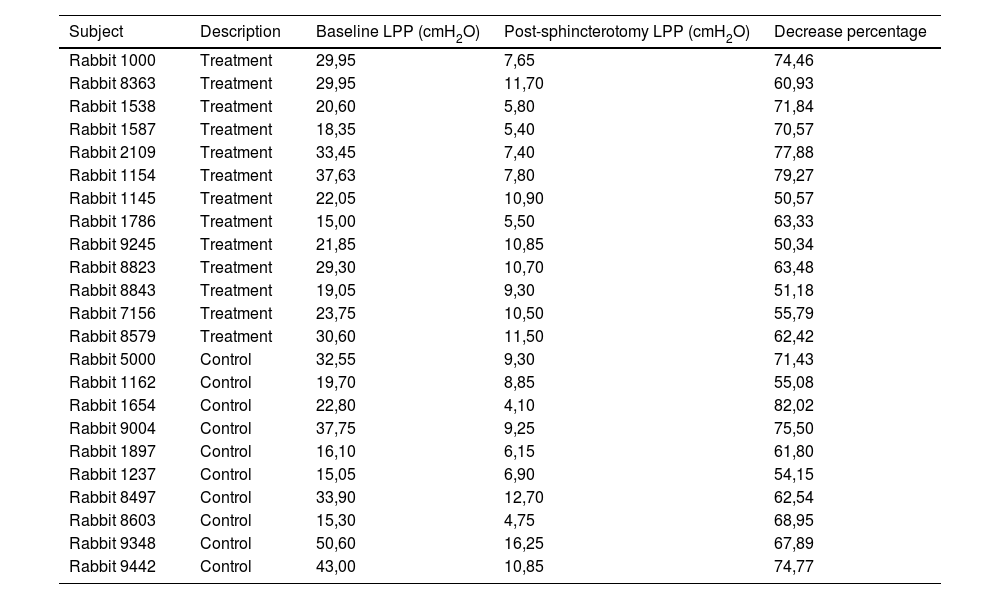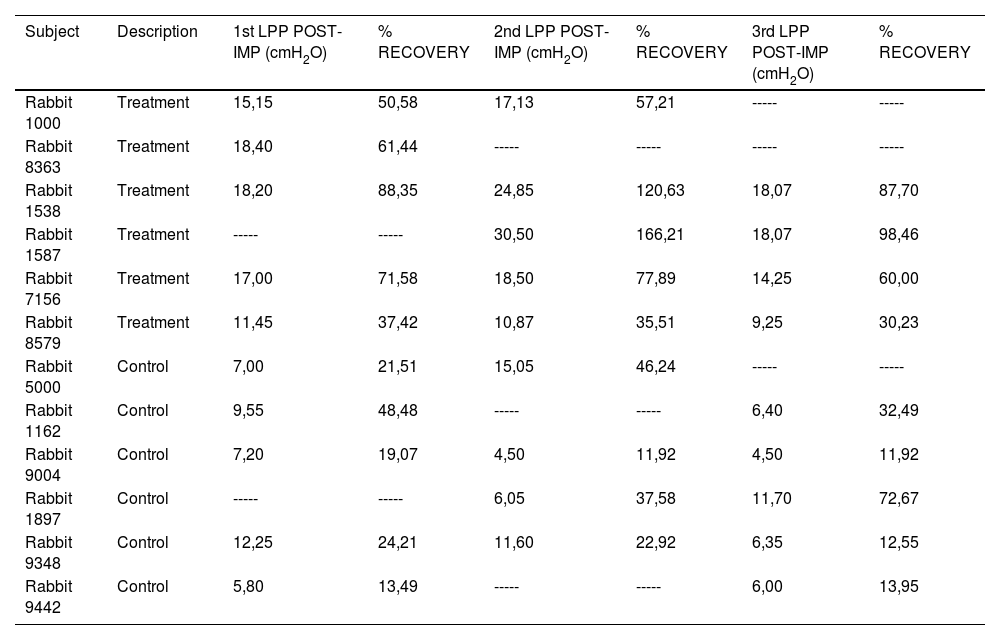Stress urinary incontinence (SUI) is one of the health problems with more impact on patients’ lives. The aim of the present work was to develop a therapy for SUI using tissue engineering by isolation and culture of autologous myoblasts (CAM) followed by endoscopic implantation. We also evaluated the efficacy of this therapy in a rabbit model of incontinence after sphincterotomy.
Materials and methodsWe used healthy male New Zealand rabbits. The animals were first bled to obtain platelet-poor plasma (PPP) and biopsied for myoblast isolation. Post-sphincterotomy, they were divided into two groups: the treatment group (including animals that received CAM resuspended in PPP) and the control group (including animals receiving only PPP). The leak-point pressure (LPP) was used to measure continence in both groups at different time points. The results were evaluated with hierarchical linear regression models. Histological evaluation of the rabbits’ sphincters was also performed at the end of follow-up.
ResultsNo statistically significant differences were observed between the baseline LPP values of each group. The post-sphincterotomy values of both groups were below 50% of the baseline value, which was a mandatory condition for incontinence. The post-implantation values of the treatment group were higher than 50% of the baseline value, which led us to assume continence recovery. A statistically significant difference was observed in the LPP values between the two treatment groups (p=0.003). Histological study revealed interconnected islands formed by muscle fibers in the treatment group, and connective tissue surrounding the urethral lumen and inflammatory infiltrate in the control group.
Discussion and conclusionsThe implantation of CAM significantly improved LPP values in the treatment group, and the improvement remained throughout the evaluation period. It may be associated with the consistency of the implant and its stability at the injection site. Longer follow-up studies and human clinical investigations are required to consider CAM implantation as an alternative treatment for stress urinary incontinence.
La incontinencia urinaria de esfuerzo (IUE) constituye uno de los problemas de salud con mayor impacto en la vida de las personas. El objetivo del presente trabajo fue desarrollar una terapia para IUE dentro de la ingeniería de tejidos mediante aislamiento y cultivo de mioblastos autólogos (MAC), su implante endoscópico y el estudio de su eficacia en un modelo de incontinencia por esfinterotomía desarrollado en conejos.
Materiales y métodosSe utilizaron conejos Nueva Zelanda, machos, sanos. Los animales fueron primero sangrados para obtención del plasma pobre en plaquetas (PPP) y biopsiados para el aislamiento de mioblastos. Posesfinterotomía, fueron divididos en dos grupos: grupo tratado (representado por aquellos animales que recibieron MAC resuspendidos en PPP) y grupo control (representado por aquellos animales que recibieron solo PPP). Se utilizó el punto de presión de pérdida (LPP) para medir la continencia de ambos grupos en diferentes instancias. Los resultados se evaluaron con modelos de regresión lineal jerárquica. Se efectuaron también estudios histológicos sobre los esfínteres de los conejos una vez finalizado el seguimiento.
ResultadosNo se observaron diferencias estadísticamente significativas entre los valores basales de LPP de cada grupo. Los valores posesfinterotomía de ambos grupos estuvieron por debajo del 50% del valor basal, condición necesaria para considerarlos sujetos incontinentes. Los valores posimplante del grupo tratado fueron superiores al 50% del valor basal, permitiendo suponer una recuperación de la continencia. Se observó una diferencia estadísticamente significativa en los valores de LPP entre los dos grupos de tratamiento (p=0,003). El estudio histológico en el grupo tratado reveló islas interconectadas formadas por fibras musculares, mientras que en el grupo control se observó tejido conectivo periférico a la luz de la uretra e infiltrado inflamatorio.
Discusión y conclusionesEl implante de MAC mejoró significativamente los valores de LPP en el grupo tratado. Dicha mejoría permaneció durante todo el período de evaluación. Esto puede asociarse a la consistencia del implante y su permanencia en el sitio de inyección. Se requieren estudios con seguimiento más prolongado e investigaciones clínicas en humanos para considerar al implante de MAC como una alternativa en el tratamiento de la incontinencia urinaria de esfuerzo.












